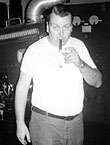|
|
This topic comprises 3 pages: 1 2 3
|
|
Author
|
Topic: Need help with questions about the silent movie era
|
|
|
|
|
|
|
|
|
|
|
|
|
Will Kutler
Phenomenal Film Handler

Posts: 1506
From: Tucson, AZ, USA
Registered: Feb 2001
|
 posted 08-19-2003 07:58 PM
posted 08-19-2003 07:58 PM




Mike,
please e-mail me at Wkutler1506@yahoo. I have some extensive info for you.
There is also a lot of info under Simplex in the manuals section of FT.
Before electric motors were introduced, both the camera and projector were hand cranked, and speed could be varied to compensate for action. Furthermore, the projectionist and musical conductor would have to work as a coordinated team.
With the advent of Sound on Disc (WE) and Sound On Film, and the addition of electric motors, machines such as the WE U-Base had a variable speed clutch for both sound and silent.
Yes, 35mm silent film can be used on modern machines. In fact the Simplex Front Shutter Standards and Regulars were first hand cranked, then motors were introduced, then these projectors were converted to rear shutter. Then they were replaced by Supers.
| IP: Logged
|
|
|
|
William Hooper
Phenomenal Film Handler
Posts: 1879
From: Mobile, AL USA
Registered: Jun 99
|
 posted 08-20-2003 01:51 AM
posted 08-20-2003 01:51 AM





quote:
2. Can an old projector (with soundhead) play a silent print? Where they standard 35mm?
Yes. But a big problem if the print is one that was actually made during the silent era will be of course shrinkage of the base.
quote:
Are new prints being made today of old silent films?
Yes. Kino films has a theatrical division which has 35mm prints of silent titles, also archives do restorations & strike new prints. Many famous, late 20s silents are still under copyright to the studios which made them. Metropolis is such an example, which coincidentally is distributed in the US by Kino
http://www.kino.com/theatrical/index.html
Turner used to have some of the silent DeMille's, like the silent Ten Commandments.
quote:
3. Do you know what the reel sizes/lengths were for silent films? The same as sound films?
Originally, the standard reel size was 1,000 feet. That's why there's that splice in the middle of your 2,000 foot reels! Of course, if you get a new print of a silent, it will come on 2,000 foot reels.
quote:
4. Were there any trailers made of silent features?
Yes, & often the only thing that remains of some "lost" silents is what's on the trailers. If he's thinking of running silents theatrically, the distributor may have new trailers for the movie.
quote:
The one question I can answer is that silent films were photographed at 16 FPS (frames per second) rather than the 24 used for sound today.
This is a modern misunderstanding which deveoped from the silent/sound switch on 16mm projectors. 16mm home movie cameras ran at 16 fps (& were silent, of course). But when theatrical sound titles got printed down to 16mm, they needed to run at 24fps of course. Short label on the switch was silent/sound.
Silent films were shot & run at speeds which could vary even within the movie! As a rule of thumb, earliest silents like from the 'teens ran slowest (around 16 fps) late silents ran faster: 24-26 fps!
A great page about silent film taking & projection speeds is at
http://www.cinemaweb.com/silentfilm/bookshelf/#March1998
quote:
unless they are re-processed with some frames duplicated the action is speeded up considerably.
That is called "stretch printing" & has distracting visual artifacts. The best way is to just project it at the correct speed. "Stretch printing" has been done for different applications - Chaplin stretch printed on of his features so it could be re-released in the sound era, but didn't like the results & preferred it to just run fast. Some silent titles with slower taking speeds were stretch printed to run on video transfer chains.
quote:
As to your Q#2, I got to see a brand new print of the Lon Chaney Phantom of the Opera in 2001 at the Orpheum Theater in Los Angeles. It was made up on a platter and played on the existing booth equipment
Was that the Kevin Brownlow restoration that was done around that time? Brownlow requires that the projector be fitted with equipment to vary the speed in accordance to notes for projection that came with the film originally (or were reconstructed by Brownlow). Kino & some other companies have 35mm prints of Phantom too (it's PD), but it's a late silent, & was taken very near & runs very well at 24fps. Phantom of the Opera is an easy silent show because you just plop it out bloop at 24fps on whatever you got.
| IP: Logged
|
|
Mitchell Dvoskin
Phenomenal Film Handler

Posts: 1869
From: West Milford, NJ, USA
Registered: Jan 2001
|
 posted 08-20-2003 08:00 AM
posted 08-20-2003 08:00 AM




1. When did nitrate prints stop being used? How long after did they circulate? Any still around?
Kodak discontinued nitrate 1950 (John, correct me if I am wrong), and by 1952 it was not longer being used in the USA. Nitrate film was manufactured in eastern europe up though the 1960's.
2. Can an old projector (with soundhead) play a silent print? Where they standard 35mm? Are new prints being made today of old silent films?
Yes. It will just run at the wrong speed unless you have a variable speed motor, or the print was modified to run at sound speed. Yes, new prints are being struck of the major silent films.
3. Do you know what the reel sizes/lengths were for silent films? The same as sound films?
Originally 1000' reels, but by the early 1920's 2000' reels.
4. Were there any trailers made of silent features?
YES. And some great art deco daters.
5. Do you know, perchance, who distributes silent films today?
In addition to Kino, which really does not have very much, Their is our Library Of Congress (requires reel to reel projection). There are a lot of small distributors. I would click Brad Allen's link, check out the "screenings" section, and call some of those venues and find out where they got their prints. You also may want to try contacting the American Theatre Organ Society ATOS for information.
| IP: Logged
|
|
|
|
Stephen Furley
Film God

Posts: 3059
From: Coulsdon, Croydon, England
Registered: May 2002
|
 posted 08-20-2003 09:50 AM
posted 08-20-2003 09:50 AM




Steve wrote:
quote:
My findings have been that most "Silent" switches and home movies actually where at 18fps, not 16fps.
Are you talking about 8mm?
18 fps is a standard speed for Super8 film, many of the single system magnetic sound on film cameras of that format run at 18fps, to reduce running costs for home use. Some of the cheaper ones only run at that speed. Super8 reduction prints of 35mm or 16mm sound films are, of course, at 24 fps., therefore Super8 sound projectors have to be able to run at both of these fixed speeds.
As for the 'silent' speeds on other guages, it's anybody's guess what they are on most machines. On some, such as the older type Bell & Howell 16mm machines, with commutator motors and governors, they are adjustable.
| IP: Logged
|
|
Tao Yue
Expert Film Handler

Posts: 209
From: Princeton, NJ
Registered: Apr 2001
|
 posted 08-20-2003 10:37 AM
posted 08-20-2003 10:37 AM





William Hooper wrote:
quote:
Turner used to have some of the silent DeMille's, like the silent Ten Commandments.
Wouldn't Paramount still hold the copyright? I'm not aware of any large-scale sale of libraries in the case of Paramount, unlike with Warners and MGM.
As far as Biblical epics at Turner, there are prints of Ben-Hur (1926) available from Warner Brothers. According to alt.movies.silents (a great resource for print info on specific titles), the prints have the 1931 syn-chro-nized soundtrack, not the Carl Davis score that was on the video version of the Brownlow restoration.
If you don't have the proper equipment to show a silent and/or don't have a pianist/organist/100-piece orchestra, your best bet is to stick with new sound-aperture prints from the late silent era. Metropolis, City Lights, Steamboat Bill, Jr., etc. All of these have soundtracks and prints that can be run at 24.
| IP: Logged
|
|
|
|
|
|
|
|
All times are Central (GMT -6:00)
|
This topic comprises 3 pages: 1 2 3
|
Powered by Infopop Corporation
UBB.classicTM
6.3.1.2
The Film-Tech Forums are designed for various members related to the cinema industry to express their opinions, viewpoints and testimonials on various products, services and events based upon speculation, personal knowledge and factual information through use, therefore all views represented here allow no liability upon the publishers of this web site and the owners of said views assume no liability for any ill will resulting from these postings. The posts made here are for educational as well as entertainment purposes and as such anyone viewing this portion of the website must accept these views as statements of the author of that opinion
and agrees to release the authors from any and all liability.
|

 Home
Home
 Products
Products
 Store
Store
 Forum
Forum
 Warehouse
Warehouse
 Contact Us
Contact Us




 Printer-friendly view of this topic
Printer-friendly view of this topic











![[Wink]](wink.gif)










